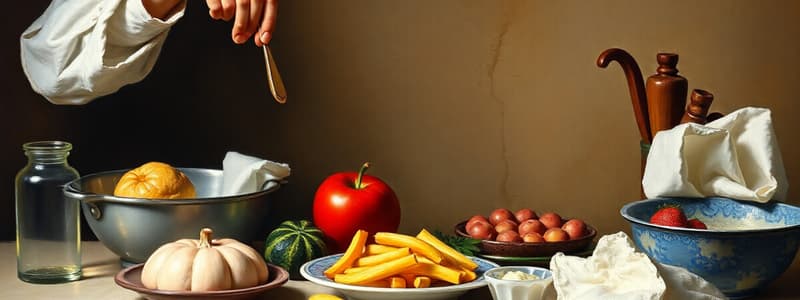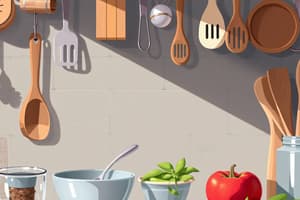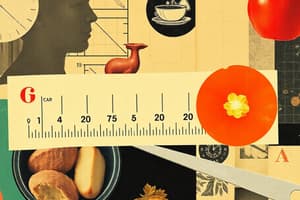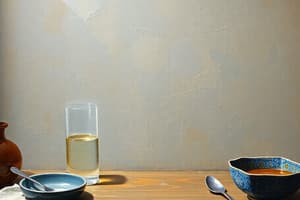Podcast
Questions and Answers
Which unit of measurement is most commonly used for liquid ingredients in the Metric system?
Which unit of measurement is most commonly used for liquid ingredients in the Metric system?
- Milliliters (correct)
- Grams
- Liters (correct)
- Pounds
What is the primary reason for accurately measuring food materials in cooking?
What is the primary reason for accurately measuring food materials in cooking?
- To reduce cooking time
- To ensure proper nutrition
- To follow recipes precisely (correct)
- To enhance the flavor only
Which of the following measuring techniques is best suited for dry ingredients?
Which of the following measuring techniques is best suited for dry ingredients?
- Using a graduated cylinder
- Using a measuring spoon for liquid
- Using a liquid measuring cup
- Using a scale for weight (correct)
What benefit does integration of measurement knowledge provide in daily cooking?
What benefit does integration of measurement knowledge provide in daily cooking?
Which of the following statements about the English and Metric systems is correct?
Which of the following statements about the English and Metric systems is correct?
What is the metric equivalent of 3/4 cup in milliliters?
What is the metric equivalent of 3/4 cup in milliliters?
How many ounces are there in 1/3 pound?
How many ounces are there in 1/3 pound?
What is the metric equivalent of 4 quarts in liters?
What is the metric equivalent of 4 quarts in liters?
Which of the following is the correct metric conversion for 2/3 lb?
Which of the following is the correct metric conversion for 2/3 lb?
What is the approximate metric equivalent of 1 cup in milliliters?
What is the approximate metric equivalent of 1 cup in milliliters?
What is the Celsius equivalent of 350°F?
What is the Celsius equivalent of 350°F?
How many tablespoons are in 1 quart?
How many tablespoons are in 1 quart?
If a recipe requires 100 grams of flour, how many cups will that be approximately?
If a recipe requires 100 grams of flour, how many cups will that be approximately?
Which of these measurements is equivalent to 1 gill?
Which of these measurements is equivalent to 1 gill?
How many pints are there in a bushel?
How many pints are there in a bushel?
Flashcards
Unit of Measurement in Cooking
Unit of Measurement in Cooking
The way food is measured, using different units like cups or tablespoons, grams or liters.
English and Metric Systems in Cooking
English and Metric Systems in Cooking
Using the English system (cups, tablespoons, ounces), or the Metric system (grams, milliliters, liters) to measure ingredients.
Converting Units of Measurement
Converting Units of Measurement
Converting one unit of measurement to another within the same system, for example: cups to tablespoons, or grams to kilograms.
Measuring Food Materials
Measuring Food Materials
Signup and view all the flashcards
Significance of Measuring in Cooking
Significance of Measuring in Cooking
Signup and view all the flashcards
1 Cup Conversion
1 Cup Conversion
Signup and view all the flashcards
1 Pint Conversion
1 Pint Conversion
Signup and view all the flashcards
1 Quart Conversion
1 Quart Conversion
Signup and view all the flashcards
1 Gallon Conversion
1 Gallon Conversion
Signup and view all the flashcards
1 Ounce Conversion
1 Ounce Conversion
Signup and view all the flashcards
Fluid Ounce (fl. oz)
Fluid Ounce (fl. oz)
Signup and view all the flashcards
Celsius (°C)
Celsius (°C)
Signup and view all the flashcards
Cup
Cup
Signup and view all the flashcards
Tablespoon (Tbsp.)
Tablespoon (Tbsp.)
Signup and view all the flashcards
Fahrenheit (°F)
Fahrenheit (°F)
Signup and view all the flashcards
Study Notes
TLE Grade 7, Quarter 3, Lesson 8
- Topic: Lesson Exemplar for Technology and Livelihood Education (TLE)
- Subject: Food Preparation and Service, Unit Conversions
- Curriculum: Matatag K to 10 Curriculum
- Year: 2024-2025
- Content Standards: Demonstrate understanding of hospitality and tourism industry fundamentals.
- Performance Standards: Apply food preparation and service skills adhering to safety precautions.
- Learning Competencies/Objectives:
- Identify food material measurement units and techniques.
- Demonstrate dry and liquid ingredient measurement techniques.
- Calculate and convert food materials using English and Metric systems.
- Appreciate the importance of accurate food material measurement.
- Content: Kitchen Math, English and Metric Systems
- Integration:
- SDG 4: Quality Education (Literacy and Numeracy)
- SDG 12: Responsible Consumption and Production (Sustainable Lifestyles)
- Learning Resources:
- Online resources (e.g., The Spruce Eats, SlideShare, etc.) on measuring techniques and conversions.
- Relevant educational materials from Fisher Valley College
- Teaching and Learning Procedure (Day 1):
- Review prior lessons.
- Identifying cooking methods from pictures.
- Clarification and Feedback
- Teaching and Learning Procedure (Day 2-3):
- Defining Key Vocabulary (Calculation, Conversion, Dry Ingredients, English System, Food Materials, Kitchen Mathematics, Liquid Ingredients, Measuring Techniques, Metric System, Unit of Measurement).
- Unlocking Content Area Vocabulary
- Discuss units of measurement and converting between the English/Imperial and Metric systems.
- Provide examples and worked exercises
- Developing and Deepening Understanding:
- Discuss kitchen math, English and metric system
- Conversion examples using English and Metric systems.
- Provide a table of US Customary (English) and Metric equivalents for volume and weight.
- Day 2 Measuring Food Materials:
- Importance of using standard tools and techniques for consistent results.
- Explanation of measuring techniques for different types of ingredients (liquids, dry).
- Procedures and common tools for measuring
- Measuring Techniques:
- Detailed procedures for measuring liquids, dry ingredients (spoons, cups, etc.), and other materials (shortening, butter, cheese).
- Emphasis on correct usage and accuracy.
- Lesson Activity (Day 3):
- Measuring Dry ingredients (brown sugar, white sugar, flour, baking soda, etc.)
- Measuring Liquid ingredients (cooking oil, concentrated milk, water, soy sauce, melted butter).
- Assessment:
- Formative assessment (converting English to Metric measurements).
- Homework:
- List of all measuring tools available and ingredients commonly measured
- Generalizations/Takeaways: Reflect on importance of accurate measurements, impact on results, and everyday significance.
- Reflection: Reflection prompts provided for teachers and learners
Studying That Suits You
Use AI to generate personalized quizzes and flashcards to suit your learning preferences.




